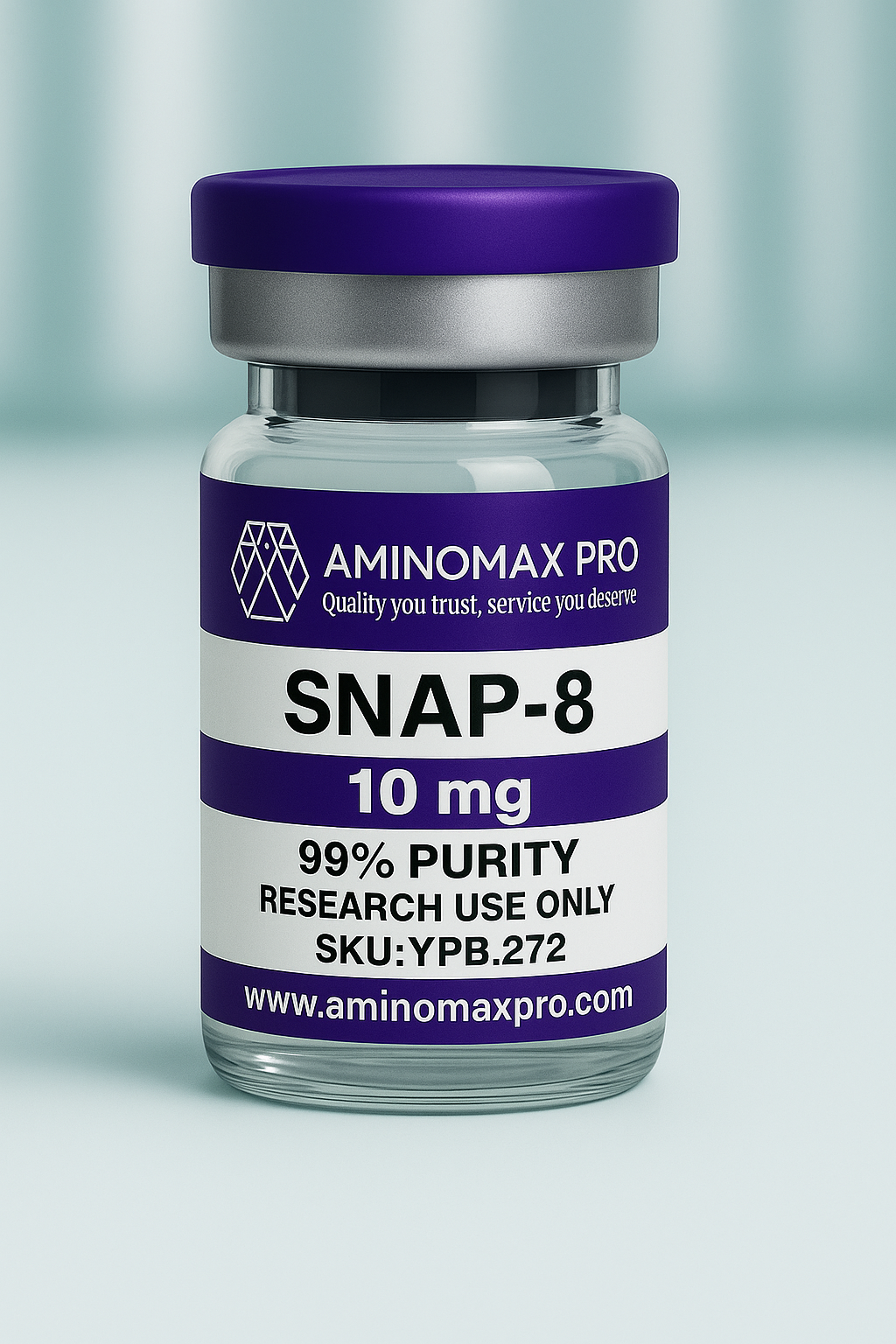Description
Snap-8 (Acetyl Octapeptide-3) – Technical Biochemical Mechanism Profile
(Argireline-Derived Octapeptide; SNARE Complex Modulation Peptide – Research Use Only)
SNAP-8 is a synthetic octapeptide analog derived from the N-terminal domain of SNAP-25, a core component of the SNARE (Soluble NSF Attachment Protein Receptor) complex.
In in-vitro biochemical assays, SNAP-8 acts as a competitive substrate analog that interferes with vesicle docking and fusion by altering SNARE protein interactions that regulate Ca²⁺-dependent neurotransmitter and neuromodulator release.
✅ 1. Core Molecular Targets
SNAP-8 interacts with components of the SNARE fusion machinery, primarily:
| Target | Function in Vesicle Fusion |
|---|---|
| SNAP-25 (Synaptosomal-Associated Protein-25) | T-SNARE protein required for vesicle docking |
| Syntaxin-1A | Plasma-membrane SNARE |
| VAMP2 / Synaptobrevin | Vesicle-associated SNARE (V-SNARE) |
| Synaptotagmin | Ca²⁺ sensor for exocytosis |
SNAP-8 mimics the N-terminal SNAP-25 domain, competing for binding and modifying complex formation kinetics.
✅ 2. Biochemical Pathway – SNARE Complex Modulation
Normal Exocytosis Sequence:
-
V-SNARE (VAMP) + T-SNAREs (SNAP-25 + Syntaxin)
-
“Zippering” of SNARE helix bundles
-
Membrane fusion
-
Vesicle release triggered by Ca²⁺-bound synaptotagmin
With SNAP-8 present (in vitro models):
-
Competes with SNAP-25 for SNARE binding sites
-
Incomplete trans-SNARE complex assembly
-
Altered helical “zippering”
-
Modified Ca²⁺-triggered vesicle fusion efficiency
-
↓ synaptic vesicle release capacity
✅ 3. Cell Signaling & Second Messengers
Although SNAP-8 does not directly activate classical receptors, downstream effects of reduced vesicle fusion can influence:
-
Ca²⁺ influx demands from voltage-gated Ca²⁺ channels (CaV2.1 / CaV2.2)
-
PKC and Calmodulin pathways linked to synaptic release
-
Feedback on cAMP–PKA signaling through reduced GPCR neurotransmitter output
✅ 4. Key Enzymes / Proteins Potentially Affected
| Enzyme / Protein | Relationship |
|---|---|
| NSF (N-ethylmaleimide–sensitive factor) | SNARE disassembly ATPase |
| α-SNAP | Binds SNARE complex for NSF recruitment |
| Synaptotagmin I/II | Ca²⁺-sensitive fusion trigger |
| Rab3A | Vesicle trafficking GTPase |
Modification of SNARE complex assembly changes vesicle fusion turnover and NSF cycling dynamics.
✅ 5. Gene Targets Often Monitored in Assays
While SNAP-8 does not directly regulate gene transcription, in vitro gene-expression studies typically monitor:
-
SNAP25, STX1A, VAMP2 (SNARE machinery)
-
SYT1 (synaptotagmin)
-
CACNA1A / CACNA1B (Ca²⁺ channels)
-
RAB3A (vesicle trafficking)
-
SLC17A7, SLC32A1 (vesicular transporters)
These genes act as biomarkers for synaptic vesicle docking and regulated exocytosis.
✅ Mechanistic Summary
-
Synthetic octapeptide derived from SNAP-25 N-terminal domain
-
Functions as competitive substrate analog for SNARE complex
-
Reduces SNARE helix formation → vesicle fusion modulation
-
Alters Ca²⁺-triggered exocytosis of synaptic vesicles in vitro
-
Does not operate through GPCRs or membrane receptors
-
Affects key proteins: SNAP-25, Syntaxin-1A, VAMP2, Synaptotagmin, NSF
✅ Research-Only Classification
SNAP-8 is supplied solely as a laboratory research chemical for in-vitro or biochemical experimentation.
Not approved for human or animal use, ingestion, injection, topical application, or therapeutic purposes.


